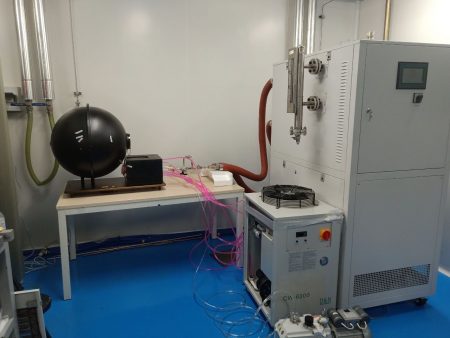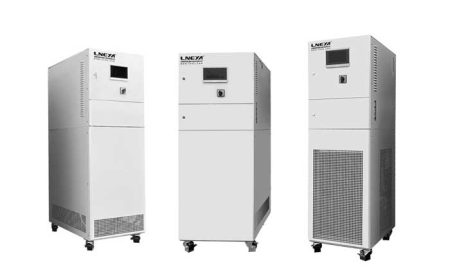Refrigerador industrial de líquidos
Industrial liquid cooler is an efficient, reliable and stable refrigeration equipment, widely used in various fields, such as semiconductor industry, biomedicine, aerospace, etc. In modern industrial production, due to the need for continuous and stable refrigeration technology, industrial liquid cooler has become one of the indispensable equipment in many industrial productions.
Technical principles of industrial liquid cooler
The working principle of industrial liquid cooler is to use the physical properties of liquid to absorb heat at low temperatures and gas to release heat at high temperatures to achieve cooling or heating through circulating flow. In an industrial liquid cooler, the compressor compresses the gas, then reduces the pressure to a lower temperature through the condenser, and finally expands the low-temperature gas through the expansion valve and discharges it. During this process, the compressor does work on the gas, increasing its pressure and temperature, thus achieving the cooling or heating effect.
In industrial liquid cooler, key components include compressor, condenser, expansion valve and evaporator. Among them, the compressor is the power source to compress gas, the condenser is a key component to cool high-temperature gas to a lower temperature, the expansion valve is an important component to expand and discharge low-temperature gas, and the evaporator evaporates low-temperature liquid into gas. parts. The precision design and manufacturing of these four components directly affects the performance and stability of industrial liquid cooler.

Industrial liquid cooler design
In order to meet the requirements for cooling or heating temperature and accuracy in different application fields, industrial liquid coolers need to be carefully designed. The following are key elements of industrial liquid cooler design:
1. Compressor selection and design. The compressor is the core component of industrial liquid cooler, and its performance and efficiency directly affect the cooling or heating effect. When selecting a compressor, factors such as compressor type, displacement, power, and lifespan need to be considered. At the same time, detailed design and calculation of the compressor is also required, including the internal structure of the cylinder, the selection and design of piston rings and bearings, and the design of the shaft seal.
2. Design of condenser. The condenser is a key component that cools high-temperature gases to lower temperatures. Its design includes both heat transfer and fluid mechanics. In terms of heat transfer, it is necessary to consider the heat exchange between the cooling medium and the compressor discharge gas, as well as the heat exchange between the cooling medium and the external environment. In terms of fluid mechanics, it is necessary to consider the influence of flow channel cross-sectional area, flow velocity, angle and other factors on heat transfer performance.
3. Design of expansion valve. The expansion valve is an important component for expanding and discharging low-temperature gas. Its design includes two aspects: pressure balance and flow regulation. In terms of pressure balance, it is necessary to consider the impact of the pressure difference before and after the expansion valve and the pressure change on the opening and closing of the expansion valve. In terms of flow regulation, the stability and accuracy of the flow control system need to be considered.
4. Design of evaporator. The evaporator is a component that evaporates low-temperature liquid into gas. Its design includes both heat transfer and fluid mechanics. In terms of heat transfer, it is necessary to consider the heat exchange between the evaporator and the compressor discharge gas, as well as the heat exchange between the evaporator and the external environment.
Ofrecemos diseño y fabricación de sistemas completos de control de temperatura. Desde modelos estándar hasta productos personalizados completos de hasta 900 toneladas. Nos especializamos en el servicio al cliente y nos dedicamos a ayudar a cada cliente a tener el sistema de control de temperatura óptimo para su necesidad específica.
Ofrecemos soluciones personalizadas no estándar. Disponemos tanto de enfriadoras individuales como de unidades combinadas de refrigeración y calefacción.
Correo electrónico: info@lneya.com WeChat ID: +8615251628237 WhatsApp: +86 17851209193

Enfriadoras de recirculación / Criotermostatos
El enfriador puede utilizarse ampliamente en diversas industrias y laboratorios, y admite diseños personalizados.
| Temperatura | Serie -25°C ~ +30°C | Serie -45°C ~ +30°C | Serie -60°C ~ -20°C | Serie -80°C ~ -20°C | Serie -120°C ~ -70°C | ||||
| Capacidad de refrigeración | 0,8 ~ 30 kW | 0,75 ~ 12 kW | 0,4 ~ 6kW | 0,2 ~ 6kW | 0,3 ~ 5kW | ||||
| Nota: Se puede personalizar cualquier rango de temperatura de -150℃ ~ +350℃ y cualquier capacidad de refrigeración. | |||||||||
 Enfriadoras de agua / Enfriadoras pequeñas
Enfriadoras de agua / Enfriadoras pequeñas
El enfriador puede utilizarse ampliamente en diversas industrias y laboratorios, y admite diseños personalizados.
| Temperatura | -18°C ~ +30°C | Serie +5°C ~ +35°C | |||||||
| Capacidad de refrigeración | 0,35 ~ 0,9 kW | 1,8 ~ 50 kW | |||||||
| Nota: Se puede personalizar cualquier rango de temperatura de -150℃ ~ +350℃ y cualquier capacidad de refrigeración. | |||||||||

Refrigeradores de baja temperatura
Estamos especializados en la producción de refrigeradores de baja temperatura con un rango de control de temperatura de hasta -150°C, que pueden satisfacer las necesidades de refrigeración de diferentes industrias.
| Temperatura | Serie -25°C ~ -5°C | Serie -45°C ~ -10°C | Serie -60°C ~ -10°C | Serie -80°C ~ -30°C | Serie -110°C ~ -50°C | Serie -150°C ~ -110°C | |||
| Capacidad de refrigeración | 12 ~ 360 kW | 6 ~ 180 kW | 6 ~ 180 kW | 4 ~ 180kW | 2 ~ 120kW | 2,5 ~ 11 kW | |||
| Nota: Se puede personalizar cualquier rango de temperatura de -150℃ ~ +350℃ y cualquier capacidad de refrigeración. | |||||||||

Refrigeradores de alta temperatura
El enfriador puede utilizarse ampliamente en diversas industrias y laboratorios, y admite diseños personalizados.
| Temperatura | +5°C ~ +40°C | -25°C ~ +40°C | -45°C ~ +40°C | -80°C ~ +80°C | -100°C ~ +80°C | ||||
| Capacidad de refrigeración | 6 ~ 40kW | 2 ~ 15kW | 1 ~ 8kW | 0,6 ~ 3 kW | 1,5 ~ 3 kW | ||||
| Nota: Se puede personalizar cualquier rango de temperatura de -150℃ ~ +350℃ y cualquier capacidad de refrigeración. | |||||||||

Enfriadoras y calefactoras
Rango de control de temperatura: -120°C a +350°C
termostato de refrigeración y calefacción, ampliamente utilizado en diversas industrias.
| Temperatura | Serie -10 ~ +150°C | Serie -25 ~ +200°C | Serie -25 ~ +300°C | Serie -45 ~ +250°C | Serie -45 ~ +300°C | Serie -60 ~ +250°C | Serie -60 ~ +300°C | Serie -70 ~ +250°C | Serie -80 ~ +250°C | Serie -90 ~ +250°C | Serie -100 ~ +100°C | ||
| Capacidad de refrigeración | 1,5 ~ 15 kW | 1 ~ 200 kW | 1 ~ 200 kW | 0,45 ~ 200 kW | 0,9 ~ 25 kW | 0,25 ~ 60 kW | 0,75 ~ 25 kW | 0,4 ~ 15 kW | 0,3 ~ 80 kW | 0,2 ~ 80 kW | 0,45 ~ 80 kW | ||
| Nota: Se puede personalizar cualquier rango de temperatura de -150℃ ~ +350℃ y cualquier capacidad de refrigeración. | |||||||||||||

Enfriadoras de recirculación
Rango de control de temperatura: -45°C a +250°C
| Temperatura | Serie -25°C ~ +200°C | Serie -45°C ~ +250°C | |||||||
| Capacidad de refrigeración | 1 ~ 15 kW | 0,25 ~ 15 kW | |||||||
| Nota: Se puede personalizar cualquier rango de temperatura de -150℃ ~ +350℃ y cualquier capacidad de refrigeración. | |||||||||
 LNEYA
LNEYA
 简体中文
简体中文


















































































